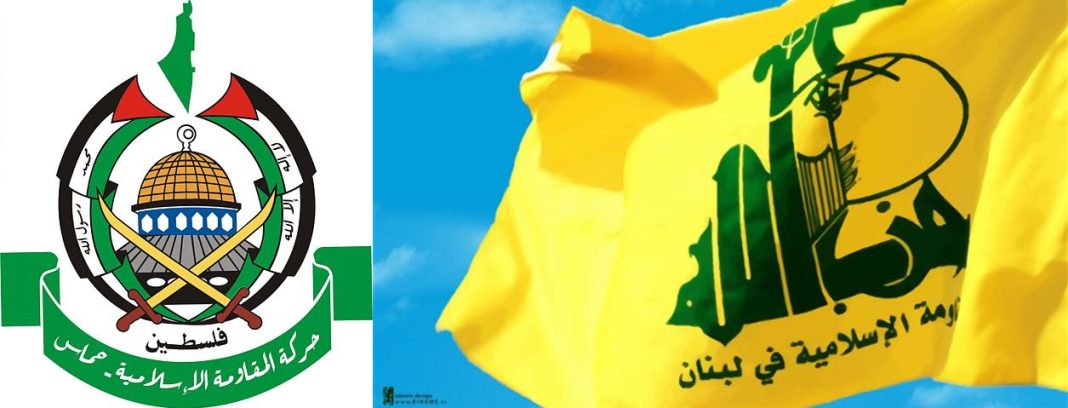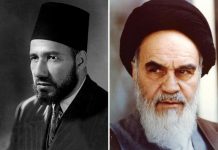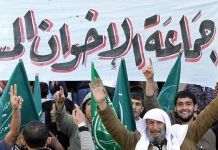نزع سلاح الفصائل الفلسطينية في لبنان يعني نزع سلاح حزب الله
حنين غدار وإيهود يعاري/معهد واشنطن/22 أيار 2025
Disarming Palestinian Factions in Lebanon Means Disarming Hezbollah
Hanin Ghaddar, Ehud Yaari/The Washington Institute/May 22/2025
Given their deep historical and present-day coordination, Beirut needs to change its mindset of treating these groups separately and formulate a unified strategy for disarming them all—and the sooner the better.
Last week, the Supreme Defense Council in Beirut warned Hamas and other Palestinian militant factions against conducting any activities in Lebanon that might jeopardize the country’s security. The warning came after a meeting in which council members and President Joseph Aoun decided to seek full disarmament inside Palestinian refugee camps. And earlier today, following talks between Aoun and Palestinian Authority President Mahmoud Abbas in Beirut, the two leaders issued a joint statement declaring an end to “weapons outside the control of the Lebanese state” and pledging that local Palestinian camps would no longer be “safe havens for extremist groups.”
Although the ceasefire agreement that ended the latest war between Israel and Hezbollah in November called for disarming all militant groups, the Lebanese government has mostly focused on dealing with Hezbollah arms between the Litani River and the southern border—at least until April, when Hamas cells in Lebanon fired a rocket salvo toward Israel, triggering more international pressure to tackle Palestinian weapons. Despite the firm tone of the new warnings from Beirut, however, they are just that—warnings. So far, officials have not laid out a clear strategy or timeframe for actual disarmament. Meanwhile, Hamas handed over two members wanted by the authorities for last month’s rocket attack but gave no indication it would surrender any of its weapons, raising questions about the government’s willingness and ability to fulfill that crucial part of the ceasefire agreement.
A Multigenerational Problem
Disarming the different factions in Lebanon’s sixteen Palestinian refugee camps is a complicated task for the limited forces currently at the government’s disposal. According to the Cairo Agreement that Beirut signed in November 1969 with Yasser Arafat under Egyptian auspices, jurisdiction over the camps was transferred from Lebanese security agencies to the Palestine Liberation Organization’s “Armed Struggle” units, a sort of police branch at the time. Lebanese forces have not ventured into the camps since then.
Today, the roughly 200,000 inhabitants in these camps include a few thousand members of multiple armed factions with varying political affiliations—mainly in the larger, more densely populated camps near Sidon, Tyre, and Tripoli, but also at camps in the Beirut area and Beqa Valley. These factions mostly operate as independent local units, though some enjoy support from Hezbollah and Iran’s Islamic Revolutionary Guard Corps-Qods Force.
Hamas is particularly prominent in the camps, with 1,500 armed fighters who closely cooperate with members of Palestinian Islamic Jihad and the local Muslim Brotherhood branch al-Jamaa al-Islamiyah, which has established its own armed outfit, the Fajr (Dawn) Forces. (Notably, a split has emerged within al-Jamaa al-Islamiyah over the past few days, with some veteran members pushing to sack current leader Mohammad Takkoush and dismantle the military branch.)
Other armed factions—such as Fatah al-Intifada and the Popular Front for the Liberation of Palestine-General Command (PFLP-GC)—counted on Syria’s Assad regime as a benefactor for years and played a minor part in Hezbollah’s attacks on Israel during the latest war. In December, soon after the Assads were ousted, the Lebanese Armed Forces announced the seizure of three PFLP-GC bases in the Beqa region. After negotiations with the LAF, however, the group retained partial control over its largest base, located in the coastal town of Naameh just south of Beirut. Fatah has an armed presence in some southern camps as well, but not all of its groups remain loyal to the PLO.
Taken together, these armed units represent the remainder of the strong PLO presence established in Lebanon between 1972 and 1982. Under Arafat’s umbrella, a wide array of Palestinian groups played a major role in fighting Christian Phalangist forces and attacking Israel in coordination with Hezbollah. Refugee camps such as Ain al-Hilweh, Rashidiya, Nahr al-Bared, and Burj al-Barajneh were the backbone of this activity; they also provided well-fortified defenses against invading Israeli forces in 1982.
Given this history, Lebanese authorities now face a deep-rooted tradition of armed groups controlling Palestinian camps for two generations, during which time they have recruited, indoctrinated, and trained countless youths and expanded their reach into neighboring cities and rural communities. Any disarmament campaign will therefore have to be handled carefully. President Aoun and his replacement as LAF commander, Gen. Rudolph Haykal, seem intent on negotiating an orderly handover of weapons and avoiding government raids that could easily devolve into extended armed conflict. Yet for reasons discussed below, some degree of confrontation may be inevitable.
Hezbollah’s Agenda, Palestinian Rifts
The prospects of reaching a settlement with Palestinian groups greatly depend on decisions taken by Hezbollah’s new military chiefs Abu Ali Haidar and Haitham al-Tabatabai. For one thing, they likely share Iran’s view that disarming Palestinians would embolden Beirut to push for Hezbollah’s complete disarmament as well. Moreover, the militia has frequently used Palestinian factions to threaten Lebanese opponents and Israel in the past, especially at times when it was hesitant to take direct action for fear of domestic or Israeli backlash. Direct action has become even riskier today, with Israel, the LAF, and officials in the U.S.-led ceasefire mechanism watching Hezbollah’s every move. Hence, the group may have intended to rely more on Palestinian factions to help assert its domestic and regional agenda during this sensitive period.
At the same time, encouraging Palestinian factions to resist disarmament would be widely unpopular in Lebanon and could ultimately drive Hezbollah into the very sort of existential domestic clash it is hoping to avoid. The group may therefore opt for procrastination.
Another potentially significant factor is Mahmoud Abbas’s role as head of the PA and PLO. During his visit to Lebanon this week, he may offer Fatah commanders in the camps alternative positions and generous benefits in exchange for disarming. Yet his power to sway them is limited given that many prominent commanders (e.g., the Miqdad brothers in Ain al-Hilweh) have switched their de facto allegiance to Hezbollah and Iran’s Qods Force even while retaining their Fatah credentials and salaries.
Even if Abbas is able to persuade the Fatah affiliates, Hamas remains the more dangerous faction and certainly will not follow his orders. On the contrary, Hamas leaders in Lebanon may try to embarrass him and flex their power by visibly using their arms during or after his visit. Another consideration is the shifting power dynamics inside Ain al-Hilweh since September 2023, when clashes with Hamas and Hezbollah weakened Fatah’s sway in the camp and enabled the other two groups to take control of local decisionmaking. Hence, if Fatah factions actually turn over their arms without Hamas following suit, they would only give more power to their rivals.
The goal of disarming these groups should also be assessed as part of the wider effort to dismantle the historical “Palestinian rejection front” in the Levant—namely, those organizations opposed to any deal with Israel. In Syria, the new government has been closing down the bases of such groups and temporarily arresting some of their leaders. In Jordan, authorities are taking firm action against underground armed networks, conducting raids and seizing rockets and drones from local Hamas and Muslim Brotherhood elements. Indeed, the aftermath of multifront war in the region has led to a concerted—though still uncoordinated—effort to eradicate the Palestinian militant presence in Arab countries neighboring Israel. And nowhere is this task more ambitious and complex than in Lebanon.
Recommendations
Given the deep historical and present-day ties between local Palestinian factions and Hezbollah, Lebanon likely cannot disarm one without disarming the other. The LAF prefers to avoid head-on confrontations for fear of stoking civil conflict with Lebanon’s Palestinian and Shia communities. Yet besides ongoing “dialogue,” military and civilian leaders in Beirut have not presented an alternative strategy to accomplish the urgent goal of disarmament.
In an Egyptian television interview last week, President Aoun announced that he was exchanging messages with Hezbollah regarding this issue but noted that it should not be carried out too hastily. He also stated that resolving certain Lebanese issues may depend on how Washington’s negotiations with Iran turn out. Yet waiting for those talks to conclude would be a mistake. The Trump administration should make clear to Lebanon that these two issues are not linked—no matter what deal Washington reaches with Tehran (if any), Beirut will still be expected to implement the ceasefire agreement with Israel and disarm all militias.
In fulfilling this commitment, Lebanese officials should formulate one strategy for disarming Palestinian groups and Hezbollah alike. Knowing the depth of their coordination, Beirut needs to change its mindset of treating these files separately.
To encourage this approach, the Trump administration should ask Beirut to follow up its latest warnings with a timetable for disarmament, setting clear deadlines for Palestinian groups and Hezbollah to lay down their weapons. Lebanese authorities will also likely need to conduct limited raids in smaller Palestinian camps to show they are serious about seeing this strategy through. They can then move on to larger camps in the south like Rashidiya and Ain al-Hilweh. If Hezbollah still refuses to disarm after receiving these strong messages, then wider confrontation may be necessary.
Of course, the price of conflict with Palestinian and Hezbollah forces would be high in terms of local casualties and damage. Yet the price of failing to disarm them would be even higher—namely, another full-fledged war with Israel and perpetual Hezbollah dominance over the country’s coffers and foreign policy.
Before the latest war, the LAF was not capable of confronting Hezbollah and its Palestinian partners, but that has changed after months of Israeli attacks transformed the group from an army to an insurgency. The LAF is now militarily capable of completing this mission, it just needs sufficient political authorization. More equipment and logistical assistance would help as well; if Beirut shows more determination, Washington should consider providing both.
The United States and its partners should also make disarmament a precondition for other kinds of assistance to Lebanon, including further financial and reconstruction help from the Gulf states. Beirut needs to understand that it must either fully implement the ceasefire agreement or face total diplomatic and financial isolation. Otherwise, the process could take more time than Lebanon can afford. The ticking clock in this case is the next parliamentary election scheduled for May 2026. If militias are not disarmed well before then, voters might lose faith in the new state and go back to the devils they know—Hezbollah and its allies.
*Hanin Ghaddar is the Friedmann Senior Fellow at The Washington Institute and author of Hezbollahland: Mapping Dahiya and Lebanon’s Shia Community. Ehud Yaari is the Institute’s Lafer International Fellow and a Middle East commentator for Israel’s Channel 12 television.
https://www.washingtoninstitute.org/policy-analysis/disarming-palestinian-factions-lebanon-means-disarming-hezbollah
نزع سلاح الفصائل الفلسطينية في لبنان يعني نزع سلاح حزب الله
حنين غدار وإيهود يعاري – معهد واشنطن – 21 أيار 2025
(ترجمة من الإنكليزية بحرية بواسطة الياس بجاني بالإستعانة بعدد من مواقع الترجمة الألكترونية)
نظرًا للتنسيق العميق، التاريخي والمستمر، بين الفصائل الفلسطينية المسلحة وحزب الله، لم يعد مقبولًا أن تتعامل بيروت مع هذه الجماعات بشكل منفصل. بل يتوجب عليها صياغة استراتيجية موحدة لنزع سلاحها بالكامل – وكلما أسرعت في ذلك، كان أفضل.
في الأسبوع الماضي، وجّه المجلس الأعلى للدفاع في بيروت تحذيرًا إلى حماس وسائر الفصائل الفلسطينية المسلحة، من القيام بأي أنشطة تُعرض أمن لبنان للخطر. جاء هذا التحذير عقب اجتماع ضم أعضاء المجلس والرئيس جوزيف عون، تقرر خلاله العمل على نزع السلاح الكامل من مخيمات اللاجئين الفلسطينيين. وفي وقت سابق من اليوم نفسه، أصدر عون ورئيس السلطة الفلسطينية محمود عباس بيانًا مشتركًا أعلنا فيه إنهاء ظاهرة “الأسلحة الخارجة عن سيطرة الدولة”، والتزما بعدم تحويل المخيمات الفلسطينية إلى “ملاذ آمن للجماعات المتطرفة”.
ورغم أن اتفاق وقف إطلاق النار الذي أنهى الحرب الأخيرة بين إسرائيل وحزب الله في تشرين الثاني/نوفمبر نص صراحة على نزع سلاح جميع الميليشيات، ركزت الحكومة اللبنانية حتى وقت قريب على سلاح حزب الله بين نهر الليطاني والحدود الجنوبية. إلا أن إطلاق خلايا حماس من لبنان وابلاً من الصواريخ على إسرائيل في نيسان/أبريل، دفع المجتمع الدولي إلى تصعيد الضغط لمعالجة ملف السلاح الفلسطيني أيضًا.
ورغم حزم اللهجة الرسمية الجديدة، لم يطرح المسؤولون بعد خطة واضحة أو جدولًا زمنيًا لتنفيذ نزع السلاح فعليًا. وفي حين سلّمت حماس اثنين من عناصرها المطلوبين على خلفية الهجوم الصاروخي، لم تُبدِ أي نية لتسليم أسلحتها، ما يطرح تساؤلات جدية حول مدى جدية الدولة في تنفيذ التزاماتها.
إرث معقد متعدد الأجيال
يمثل نزع سلاح الفصائل المنتشرة في المخيمات الفلسطينية الستة عشر في لبنان تحديًا معقدًا للقدرات المحدودة للدولة. فبموجب اتفاق القاهرة عام 1969، سُلّمت السيطرة الأمنية على المخيمات من السلطات اللبنانية إلى “قوات الكفاح المسلح” التابعة لمنظمة التحرير الفلسطينية، ومنذ ذلك الحين، لم تدخل القوى الأمنية اللبنانية تلك المخيمات. ويعيش في هذه المخيمات نحو 200 ألف شخص، من بينهم آلاف المقاتلين المنتمين إلى فصائل مختلفة، أبرزها حماس والجهاد الإسلامي و”الجماعة الإسلامية” التي شكّلت ذراعًا عسكرية تُعرف بـ”قوات الفجر”. وقد برز مؤخرًا انقسام داخل الجماعة الإسلامية، أسفر عن إقالة قائدها العسكري محمد طقوش وتفكيك جناحه المسلح. أما فصائل مثل فتح الانتفاضة والجبهة الشعبية لتحرير فلسطين – القيادة العامة، فلطالما اعتمدت على النظام السوري كداعم رئيسي، ولعبت دورًا محدودًا في هجمات حزب الله خلال الحرب الأخيرة. ورغم أن الجيش اللبناني سيطر في كانون الأول/ديسمبر الماضي على ثلاث قواعد للجبهة في البقاع، إلا أن تسوية سياسية أبقت على سيطرتها الجزئية على قاعدتها الأساسية في الناعمة جنوب بيروت.
تشكل هذه الفصائل ما تبقى من نفوذ منظمة التحرير الفلسطينية الذي ترسخ في لبنان بين 1972 و1982، حين شاركت، تحت قيادة عرفات، في القتال ضد حزب الكتائب وضد إسرائيل بالتنسيق مع حزب الله. وكانت مخيمات مثل عين الحلوة، الرشيدية، نهر البارد، وبرج البراجنة مركزًا أساسيًا لهذا النشاط، بل ووفرت تحصينات منيعة خلال الاجتياح الإسرائيلي عام 1982. واليوم، تواجه السلطات اللبنانية واقعًا عمره جيلان من النفوذ المسلح في هذه المخيمات، حيث تجذّرت تلك الجماعات ووسّعت نفوذها ليطال المدن المجاورة والمجتمعات الريفية. وبالتالي، فإن أي خطة لنزع السلاح يجب أن تكون مدروسة وحذرة. ويبدو أن الرئيس عون وخليفته في قيادة الجيش، العماد رودولف هيكل، يفضلان التفاوض على تسليم منظم للأسلحة، لتجنّب اندلاع صراع داخلي واسع.
حزب الله… العائق الأكبر
فرص النجاح في التفاوض مع الفصائل الفلسطينية ترتبط بشكل وثيق بموقف القادة العسكريين الجدد في حزب الله، أبو علي حيدر وهيثم الطباطبائي، اللذين يتماهيان على الأرجح مع الموقف الإيراني الرافض لنزع سلاح الفلسطينيين، خشية أن يُستخدم ذلك كمقدمة لنزع سلاح الحزب ذاته. لطالما استخدم حزب الله هذه الفصائل كورقة ضغط داخلية وخارجية، خصوصًا في أوقات لا يرغب فيها بخوض مواجهة مباشرة مع إسرائيل أو خصومه اللبنانيين. ومع مراقبة إسرائيل والجيش اللبناني واللجان الدولية لأي تحرك، قد يرى حزب الله في الفصائل الفلسطينية أداة مثالية لتمرير أجندته دون أن يتحمل الكلفة مباشرة.
ومع ذلك، فإن دعم هذه الفصائل في تحدي الدولة سيؤدي إلى نقمة شعبية لبنانية واسعة، وربما يجر الحزب إلى صراع داخلي هو في غنى عنه. لذلك، قد يفضّل حزب الله التريّث والمماطلة. عامل آخر يتمثل في دور محمود عباس، الذي قد يعرض مناصب ومزايا لقادة فتح مقابل تسليم السلاح. لكن تأثيره محدود، إذ إن بعض القادة (مثل الإخوة مقداد في عين الحلوة) انحازوا فعليًا إلى حزب الله وفيلق القدس، رغم بقائهم رسميًا ضمن فتح. أما حماس، فهي الطرف الأخطر، ولن تستجيب لعباس. بل قد تستغل زيارته لإظهار تحدٍ علني يعزز حضورها. وتُضاف إلى ذلك التحولات الأخيرة في عين الحلوة، حيث أضعفت الاشتباكات نفوذ فتح، ما عزز سطوة حماس وحزب الله على القرار داخل المخيم.
تفكيك “جبهة الرفض”… من لبنان إلى الشام
نزع سلاح الفصائل في لبنان لا يمكن فصله عن الجهود الإقليمية الأوسع لتفكيك “جبهة الرفض الفلسطينية”، التي تعارض أي تسوية مع إسرائيل. ففي سوريا، أغلقت الحكومة الجديدة قواعد هذه الفصائل واعتقلت بعض قادتها. وفي الأردن، تنفذ السلطات مداهمات وتضبط أسلحة وطائرات مسيّرة بحوزة حماس والإخوان المسلمين.
لكن المهمة الأصعب والأكثر تعقيدًا تبقى في لبنان.
التوصيات
بسبب الترابط العميق بين الفصائل الفلسطينية المسلحة وحزب الله، فإن نزع سلاح أي طرف دون الآخر غير ممكن. الجيش اللبناني يفضّل تجنب المواجهة خوفًا من انفجار داخلي مع الفلسطينيين والشيعة، لكن “الحوار” وحده لا يكفي. ولا تزال بيروت تفتقر إلى خطة عملية. وقد أشار الرئيس عون، في مقابلة تلفزيونية أخيرة، إلى تبادل رسائل مع حزب الله بهذا الشأن، لكنه شدد على ضرورة عدم التسرع. وربط بعض الحلول الداخلية بمسار مفاوضات واشنطن مع طهران – وهذا خطأ. يجب أن توضّح إدارة ترامب أن تنفيذ اتفاق وقف إطلاق النار مع إسرائيل ونزع سلاح الميليشيات هو أمر مستقل عن أي مفاوضات مع إيران. وبالتالي، يجب على بيروت وضع خطة موحدة لنزع سلاح كل من الفصائل الفلسطينية وحزب الله. كما ينبغي لإدارة ترامب أن تدفع لبنان إلى تحديد جدول زمني واضح لإتمام ذلك، مدعومًا بإنذارات نهائية للفصائل. ويمكن أن تبدأ العملية بمداهمات محدودة في مخيمات صغيرة، ثم التوسع نحو مخيمات الجنوب الكبرى كعين الحلوة والرشيدية. إذا استمر حزب الله في الرفض، فقد تصبح المواجهة الكبرى حتمية.
صحيح أن ثمن هذه المواجهة سيكون باهظًا، لكن كلفة الفشل ستكون أفدح: حرب شاملة مع إسرائيل، وبقاء حزب الله مهيمنًا على مقدرات الدولة وقرارها الخارجي. قبل الحرب الأخيرة، لم يكن الجيش اللبناني قادرًا على مجابهة حزب الله وحلفائه، لكن المعادلة تغيّرت بعد الضربات الإسرائيلية المكثفة. أصبح الجيش الآن مؤهلاً عسكريًا، لكنه بحاجة إلى تفويض سياسي ودعم لوجستي. وإذا أظهرت بيروت جدية، فعلى واشنطن تقديم المساعدة اللازمة.
وأخيرًا، ينبغي على الولايات المتحدة وشركائها الدوليين اعتبار نزع السلاح شرطًا مسبقًا لأي دعم سياسي أو اقتصادي للبنان.






















